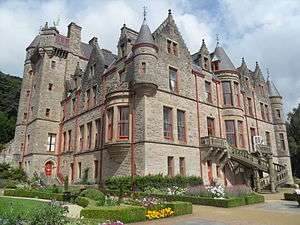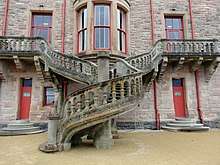Belfast Castle
Belfast Castle is set on the slopes of Cavehill Country Park, Belfast, Northern Ireland, in a prominent position 400 feet (120 m) above sea level. Its location provides unobstructed views of the city of Belfast and Belfast Lough.

History
Built by the Normans in the 12th Century, the original Belfast castle sat within the city of Belfast itself. In 1611, Sir Arthur Chichester, Baron of Belfast (later Marquess of Donegall),[1] replaced the old castle with one made of stone and timber, building on the same spot as the original castle.[2]
In 1708, Sir Arthur's castle burned down.[1] Because the castle's location was changed, the original site was turned into streets named in honor of the previous castles.[2] Rather than rebuilding on the same site, a new castle was built on Cave Hill (north of Belfast) with construction starting in 1862 and not ending until 1870.[2] Architect John Lanyon designed the new building in the then-popular Scottish baronial style. Construction cost well over the ₤11,000 set aside to pay for the project. Sir Arthur's son in law, Lord Ashley 8th Earl of Shaftesbury paid for the reconstruction and later inherited the castle in 1884. Lord Ashley, his wife, Harriet Augusta, and their ancestors are honored and remembered in the form of Belfast street names, much like how the original castles are remembered.[2]
The Shaftesbury family were not only the castle's residents and owners, but they were also generous donors to the city of Belfast and hosted events at their home. The ninth Earl even became Belfast's mayor in 1907. The castle remained a private estate until the entire property was gifted to the city in January 1934,[2] the process of which became a topic of public interest in the years prior to the official presentation to the city. In the years after it was given to the city, there was some debate about what the castle should be used for. The publicity manager that the castle should either be re-purposed into a tea and dance room, or perhaps a museum and art gallery with refreshment rooms.
The castle was just the beginning. The publicity manager also made plans for the grounds to include an open-air theatre, clay pigeon shooting, archery, tennis courts, bowling greens, squash courts, and mini golf. With such an ambitious project, a sub-committee estimated that the minimum possible cost would be ₤160,000 before considering the cost of employing grounds keepers and the cost of restoring the building.
Since 1945, the castle has been a popular venue for weddings, afternoon teas, and other such events.[2]
Location
Belfast Castle is located 400 feet (121.92 meters) above sea level on Cave Hill overlooking Belfast, County Antrim, Northern Ireland.[2]
Facilities
Belfast Castle is open to the public daily with a visitor center, antique shop, restaurant, and a playground. Visitors can see a bedroom, set up in the style of the 1920s so visitors can see a snapshot in time of what the castle looked like at the end of its life as a private estate.[2]

While it is open to the public daily, reservations can be made for a private room to host weddings, business meetings, and parties.[2]
Structure
Since its construction in the 1860s, the castle's sandstone walls and towers have been restored. The castle is built in the Scottish baronial style, which was born out of rising Gothic styles in the 16th Century as part of the Scottish Renaissance. Scottish baronial style castles were typically built on asymmetrical plans and included high roofs, towers, and turrets to display the owner's status.
One of the castle's most iconic features is the winding staircase at the entrance, whose greyish-brown color stands out against the burnt sienna sandstone and brick red detail.[3]
As in the 20th Century, many of the rooms have been turned into public tea rooms or are available to be reserved for private functions.[3]
Restoration
After years of successful business and popularity, the castle was closed in 1978 for a refurbishing effort. The architecture partnership of Hewitt and Haslam oversaw and carried out the over ₤2 million project, with the estate reopening on 11 November 1988. Since then, it has once again become a popular spot for weddings and other celebrations as well as for business meetings.[1]
Another example of events held at the castle is the 2015 Belfast Castle Hospice walk, held by Northern Ireland Hospice to benefit local charities and those living with terminal illnesses.[4]
The castle underwent another round of refurbishment in May 2003.
References
- "Irish Castles - Belfast Castle". www.britainirelandcastles.com. Retrieved 2019-12-05.
- "History of Belfast Castle". www.belfastcastle.co.uk. Retrieved 2019-12-05.
- "Belfast Castle | venuedirectory.com". www.venuedirectory.com. Retrieved 2019-12-05.
- "Ireland: Belfast Castle Hospice Walk". link.galegroup.com. Retrieved 2019-12-05.

